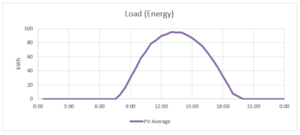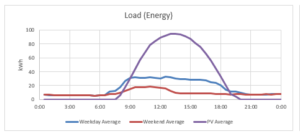In-House Solar Feasibility Studies Optimisation
Performing the feasibility study of the solar PV system installation is critical to give the true picture of the possible outcome. A feasibility study can be broken into three main processes: the mandated studies, investigation, and economics and financial assumptions.
The investigation segment encompasses the study of potential challenges that would impact the lifespan of the solar PV system. As with these scenarios, the client’s energy profile – goals and needs – should be addressed to capture the potential variables that would lead to the various direction in determining if the most viable solution for the client. Not only are the energy needs of the client important to comprehend, but so is the energy demand curve profile. In fact, understanding the energy profile is a crucial component of the feasibility study, and most clients do not know their energy usage. LYS Energy Studies’ experts undertake considerable efforts to educate its clients and give them not only a subjective picture of how the load is used but also the key component on when and how the heaviest electrical loads occur daily.
As solar electricity is essentially variable -- intermittent due to solar cycles of the sun and unpredictable weathers -- yet predictable by studying the time of day, location, seasons and, etc. LYS Energy Group reminds the paramount importance to carry out the load curve analysis prior to designing and, installation of solar panels on your rooftop.
Feasibility Study: The Load Curve Analysis
LYS Energy Group has implemented its in-house load curve analysis built by the Design & Studies team of experts and continuously refines blueprints to kickstart our clients’ projects.
Indeed, after studying the configurated data, calculation works are carried out to distinctly calculate the Client’s load curve – obtained from its 30 minutes energy consumption throughout a whole year – versus the export of energy (generated solar energy that is non-consumed by the building). By overlaying the expected PV production curve with the client load curve, we get the total energy that will be exported to the grid. And the solar PV production curve is found by using the average daily PV production with the bell-shaped distribution.
The Issues
Expectedly, there are several issues to consider. The bell-shaped distribution in figure 1.0 as shown below, illustrates the representation of daily output from the PV system, using the average of production to derive an export.

Fig 1.0 – Solar PV system daily output illustration
The solar PV system’s energy production will vary with the irradiation – real-time weather conditions such as clouds, weather conditions, etc. -- external factors that could significantly impact the production.
From our existing systems monitoring in Singapore, month-to-month analysis has shown important seasonality i.e.: months like September to December usually generate lower production, for example. Thus, simply using an average of the PV system production does not do justice to the pattern of the export.
The Solution
To get a clear reflection of the pattern of the energy export, LYS experts use its in-house analysis tool based on a 30min irradiance data from our existing assets to distribute the PV production. As shown in Figure 2.0, the graph demonstrates the daily PV production distributed as per recorded irradiance data. It deduces that the overlay of this curve with the client load will not give the same result as the overlay with a perfect bell shape.
 Fig 2.0 – Solar PV system average daily production versus clients’ load curve
Fig 2.0 – Solar PV system average daily production versus clients’ load curve
The Key Takeaway
By using its in-house analysis tool based on a 30min irradiance data from our existing assets to distribute the PV production, LYS Energy Group delivers a more accurate estimation of the solar PV system's contribution to the load reduction, and a better estimation of the export of the solar electricity to the grid. Indeed, this evaluation translates to higher accuracy in savings calculations and financial modeling. This best practice allows LYS Energy to deliver to clients the best economic savings guaranteed -- price vs energy output and reflects in the meantime, the actual alignment of the quality and high-performance standards of the Group’s solar PV systems across the region.
